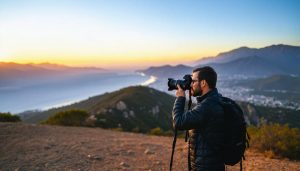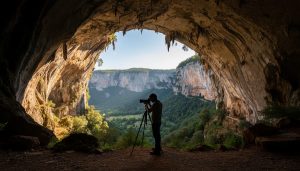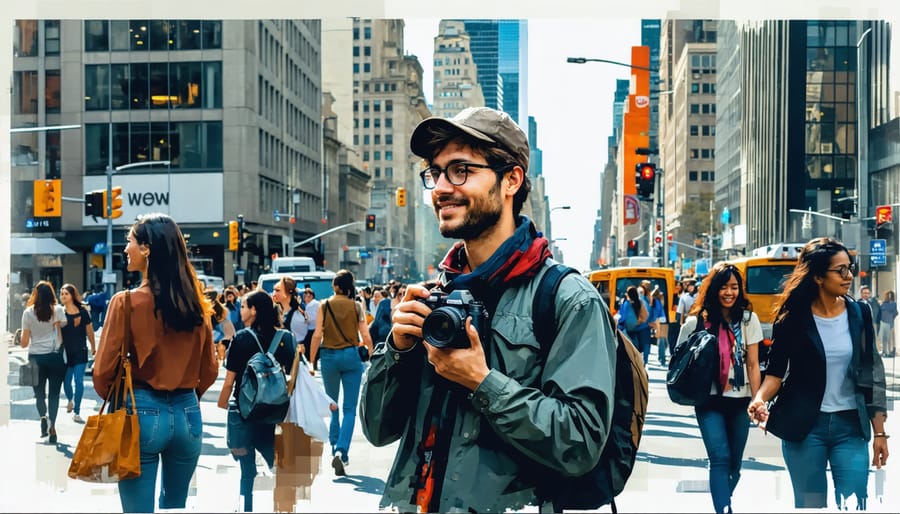
Respect your subjects’ privacy and personal space. Before taking a candid photo of someone, consider how you would feel in their position. If the scene feels too intimate or the subject appears uncomfortable, move on.
Seek permission when appropriate. For portraits or photos where an individual is the clear focus, it’s best to get their consent first, especially if you intend to publish the image. A friendly smile and quick explanation often suffice.
Prioritize empathy over getting the shot. If someone objects to having their photo taken, graciously accept their wishes and delete the image if needed. No photo is worth violating someone’s dignity or sense of agency.
Know and follow local laws and customs. Street photography etiquette and legality varies worldwide. Familiarize yourself with the relevant regulations and cultural norms in your shooting location to avoid unintentional offenses or legal issues.
Represent people honestly and fairly. Strive to capture authentic, unposed moments, but resist the urge to sensationalize or take images out of context. As a street photographer, you have a responsibility to portray your subjects and communities with accuracy and respect.
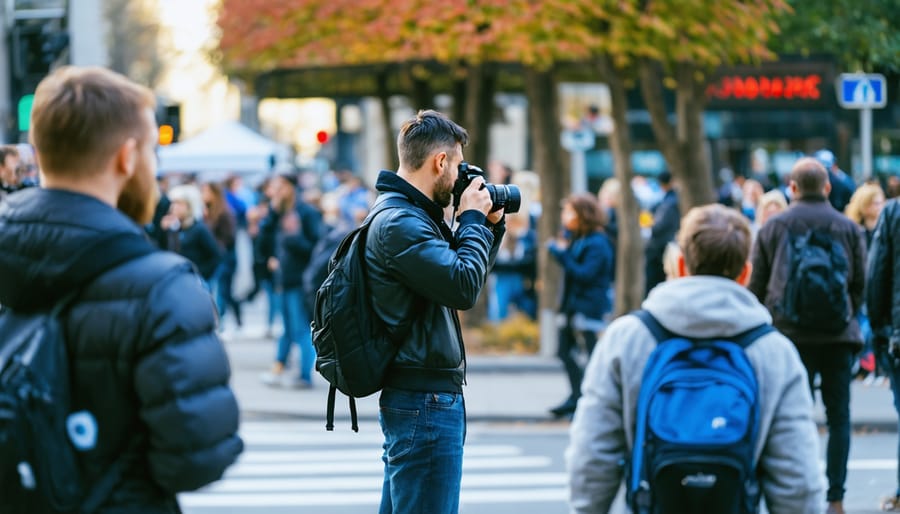
The Legal Landscape of Street Photography
Public vs. Private Property
Understanding the distinction between public and private property is crucial for street photographers. In most countries, you generally have the right to take photographs in public spaces without explicit permission. This includes streets, sidewalks, parks, and other areas accessible to the public. However, the rules change when it comes to private property. Even if a privately-owned space is open to the public, like a shopping mall or office building lobby, the property owner has the right to set rules regarding photography on their premises.
It’s important to be aware of signage indicating photography restrictions and to respect any requests to stop shooting by property owners or their representatives. If you’re unsure whether an area is considered public or private, it’s always best to ask for clarification or permission before taking photos to avoid potential conflicts.
Keep in mind that while you may have the legal right to photograph in public spaces, it’s still important to exercise good judgment and be respectful of people’s privacy. If someone objects to having their photo taken, it’s often best to simply apologize and move on. By staying informed about property laws and maintaining a courteous approach, you can navigate the world of street photography with confidence and integrity.
Model Releases: When Are They Needed?
When it comes to street photography, the general rule is that you don’t need a model release for photos taken in public spaces. However, there are some situations where obtaining a release is necessary or advisable. If you plan to use the images for commercial purposes, such as in advertisements, on product packaging, or for stock photography, securing a model release is crucial. This protects you from potential legal issues down the line.
Even if you’re not using the photos commercially, it’s a good idea to get a release if the subject is recognizable and the image could be considered unflattering or sensitive in nature. For instance, if you capture a homeless person in a vulnerable state, it’s more ethical to obtain their permission before publishing or sharing the photo widely.
In some countries, stricter privacy laws may require a model release for any published photo where an individual is identifiable, regardless of the context. It’s always wise to research the specific regulations in your area. When in doubt, err on the side of caution and respect for your subjects – if you feel a release is appropriate, take the time to explain your intentions and secure written permission.
Respect, Consent and ‘The Golden Rule’
Unposed vs. Posed Street Portraits
When it comes to street photography, there’s an important distinction between candid, unposed shots and posed portraits of individuals. While capturing spontaneous moments is often the essence of street photography, taking identifiable posed street portraits requires a different approach. In these cases, it’s crucial to obtain permission from your subject before proceeding.
Engaging with your potential subject, explaining your intentions, and seeking their consent shows respect for their privacy and autonomy. It allows them to make an informed decision about participating in your photographic vision. This dialogue also presents an opportunity to build rapport, potentially leading to more authentic and compelling portraits.
Remember, while public spaces may not legally require permission for photography, ethics and empathy should guide our actions. Treat others as you would want to be treated. By prioritizing consent and open communication, we can create street portraits that are both visually striking and morally sound, fostering a positive relationship between photographers and the communities they aim to capture.
Photographing Children and Sensitive Situations
Photographing children and people in sensitive situations requires extra care and ethical considerations. Always prioritize the well-being and privacy of your subjects. When photographing minors, obtain explicit permission from their parents or guardians. Be mindful of capturing children in any state of undress or engaged in activities that could be misinterpreted.
For adults in vulnerable positions, such as the unhoused or those facing hardship, approach with empathy and respect. Consider if your presence is intrusive or exploitative. Engage in conversation when appropriate, and be prepared to delete images if requested. Avoid photographing people in medical distress, compromising situations, or while emotionally distraught.
In some locales, photographing minors or certain sensitive subjects may be legally restricted. Familiarize yourself with local laws and customs. When in doubt, err on the side of caution and compassion. Remember, the documentary power of street photography comes with a responsibility to uplift our shared humanity.

Intent and Representation in Street Photos
When capturing candid moments on the streets, it’s crucial to be mindful of how you portray your photo subjects. Your intent should never be to mock, ridicule, or exploit the people you photograph. Instead, aim to capture the authentic essence of a scene or individual, while treating them with dignity and respect.
Before pressing the shutter button, take a moment to consider the potential impact of your image. Will it ensure your intent is not to mock, embarrass or misrepresent the subject? Could it be interpreted as an invasion of privacy or a display of power imbalance? These are important questions to ask yourself as you navigate the world of street photography.
One way to ensure your photos are respectful is to put yourself in the subject’s shoes. Consider how you would feel if someone captured a candid moment of you without your knowledge or consent. Would you be comfortable with the way you were portrayed? This empathetic approach can guide your decision-making process and help you create images that are both powerful and ethical.
It’s also important to be aware of the cultural and social context in which you’re photographing. What may be considered acceptable in one community might be seen as offensive or disrespectful in another. Take the time to learn about the norms and values of the places you visit, and adjust your approach accordingly.
Ultimately, the key to ethical street photography is to approach your subjects with compassion, sensitivity, and a genuine desire to tell their stories honestly. By being mindful of your intent and striving to represent people fairly, you can create images that inspire, educate, and connect us all.
Handling Confrontations and Requests to Delete Photos
When confronted by an unhappy subject while doing street photography, the best approach is to remain calm, respectful, and empathetic. Apologize if they feel you’ve intruded on their privacy, and explain your artistic intent. Offer to show them the photo and delete it on the spot if they’re truly uncomfortable.
If someone requests you delete a photo after the fact, consider their perspective carefully. While you may legally have the right to keep the image in most public settings, it’s often best to honor the subject’s wishes out of respect. Deleting one photo is a small price to pay for maintaining positive relationships and the overall reputation of street photographers.
However, if deleting the photo would mean losing a truly special or irreplaceable moment, try to find a compromise. Offer to obscure the subject’s identifying features before publishing, or provide them with a copy of the photo for their own use as a gesture of goodwill.
In any confrontation, prioritize de-escalation and understanding over being “right.” Carry business cards explaining your purpose as a street photographer, and be prepared to walk away if a subject becomes hostile. Your safety and the integrity of your work are paramount.
Remember, the vast majority of people will be flattered to be the subject of an artistic photograph. Approach your craft with confidence, but also with sensitivity and a willingness to engage in polite dialogue. By treating people with respect, you’ll find that confrontations are rare, and you can focus on capturing the beauty and humanity of everyday moments on the street.
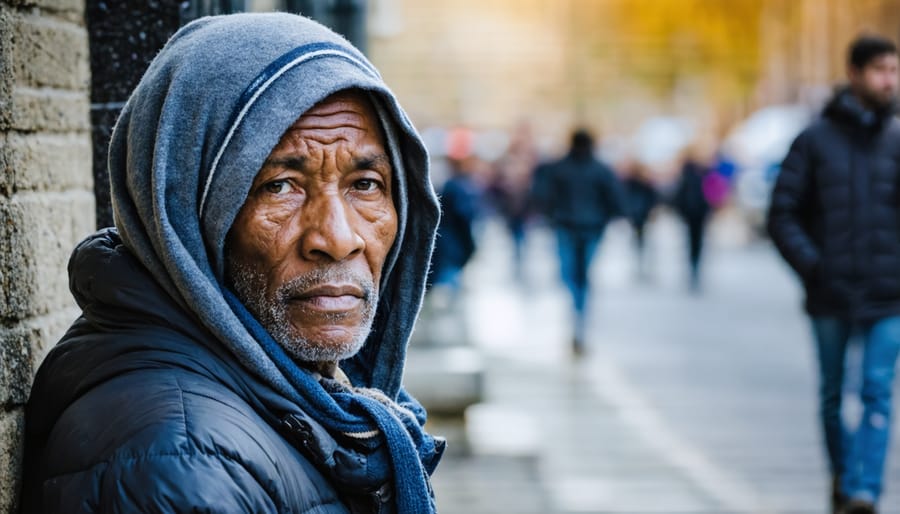
In conclusion, street photography ethics is a complex and nuanced topic that requires careful consideration from each practitioner. As photographers, we have the power and responsibility to shape narratives and influence perceptions through our images. It’s crucial to establish personal ethical boundaries that align with legal requirements, cultural sensitivities, and respect for individual privacy. Empathy, open communication, and a commitment to representing subjects authentically should be at the core of every street photographer’s approach. By challenging ourselves to striving to create compelling visual stories while upholding high ethical standards, we can contribute to a richer, more nuanced understanding of the world around us. Ultimately, the goal is to balance artistic expression with respect for the human experience, fostering a street photography community that values both creativity and integrity. As you embark on your own street photography journey, take the time to reflect on your values, engage in ongoing learning, and adapt your practices to prioritize ethics at every stage of the process. In doing so, you’ll not only create more impactful images but also contribute to a more positive and responsible photographic culture as a whole.



